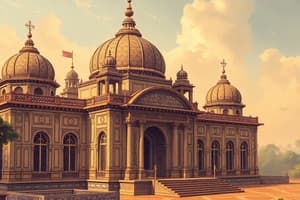Podcast
Questions and Answers
साम्राज्याच्या अंतिमकाळात, महाराष्ट्राच्या इतिहासातील कोणते दशक होते?
साम्राज्याच्या अंतिमकाळात, महाराष्ट्राच्या इतिहासातील कोणते दशक होते?
- १८५०
- १६००
- १९५०
- १८१८ (correct)
सम्युक्त महाराष्ट्र आंदोलन कधी सुरू झाले?
सम्युक्त महाराष्ट्र आंदोलन कधी सुरू झाले?
- इ.स. १९५० (correct)
- इ.स. १८५०
- इ.स. १९६०
- इ.स. १९००
महाराष्ट्रातील समाजिक सुधारणा आंदोलनांमध्ये कोणता क्रांतिकारक भाग घेतला?
महाराष्ट्रातील समाजिक सुधारणा आंदोलनांमध्ये कोणता क्रांतिकारक भाग घेतला?
- राजा राममोहन राय
- विद्यासागर
- महात्मा फुले (correct)
- डॉ. आंबेडकर
महाराष्ट्र सम्राज्याच्या समुंदर कडेवर कोणत्या संप्रदाया संघर्ष केला होता?
महाराष्ट्र सम्राज्याच्या समुंदर कडेवर कोणत्या संप्रदाया संघर्ष केला होता?
'विद्यासागर' आंदोलननिमित्त कोणत्या पुरुषने हिंदू समाजाचे सुधरे केले?
'विद्यासागर' आंदोलननिमित्त कोणत्या पुरुषने हिंदू समाजाचे सुधरे केले?
'तपसील' कुंपण केलेला विचारला जातो.
'तपसील' कुंपण केलेला विचारला जातो.
ब्रिटिश सत्ताधारींनी महाराष्ट्रात काय बदल केलं?
ब्रिटिश सत्ताधारींनी महाराष्ट्रात काय बदल केलं?
मराठा साम्राज्य कोणत्या कालावधीत अस्तित्वात होता?
मराठा साम्राज्य कोणत्या कालावधीत अस्तित्वात होता?
मराठा साम्राज्य कोणाकडून स्थापित केले गेले?
मराठा साम्राज्य कोणाकडून स्थापित केले गेले?
Flashcards
British Rule in Maharashtra
British Rule in Maharashtra
The period of British control over Maharashtra, beginning with the annexation of the Maratha Empire in 1818 and ending with Indian independence in 1947. This rule saw major changes in administration, education, and infrastructure but also caused exploitation and suppression of the Indian independence movement.
Maratha Empire
Maratha Empire
A powerful Indian empire founded by Shivaji Maharaj in the 17th century, known for its military prowess and expansion. It eventually fell to British control in 1818, marking a turning point in Maharashtra's history.
Samyukta Maharashtra Movement
Samyukta Maharashtra Movement
A significant movement in the 1950s and 1960s that aimed to unify Marathi-speaking regions of the Bombay Presidency into a separate state of Maharashtra.
Maharashtra Statehood
Maharashtra Statehood
Signup and view all the flashcards
Jyotirao Phule
Jyotirao Phule
Signup and view all the flashcards
Ishwar Chandra Vidyasagar
Ishwar Chandra Vidyasagar
Signup and view all the flashcards
Dr. B.R. Ambedkar
Dr. B.R. Ambedkar
Signup and view all the flashcards
Social Reform Movements in Maharashtra
Social Reform Movements in Maharashtra
Signup and view all the flashcards
Modern History of Maharashtra
Modern History of Maharashtra
Signup and view all the flashcards
Study Notes
Modern History of Maharashtra
Maharashtra, a state in western India, has a rich and diverse history. This article will delve into the modern history of Maharashtra, focusing on the British rule, the Maratha Empire, the Samyukta Maharashtra Movement, the Maharashtra statehood, and social reform movements in the region.
British Rule in Maharashtra
British rule in Maharashtra began in the early 19th century with the annexation of the Maratha Empire. The British East India Company, which had already established a foothold in India through trade, saw an opportunity to expand its territories and influence. In 1818, the Treaty of Poona was signed between the British and the Maratha Empire, effectively marking the end of the Maratha Empire and the beginning of British colonial rule in Maharashtra.
The British rule in Maharashtra brought significant changes to the region. They introduced new administrative systems, educational institutions, and infrastructure projects. However, their rule also led to the exploitation of local resources and the suppression of the Indian independence movement.
Maratha Empire
The Maratha Empire, which existed from the 17th to the 19th century, was a powerful political entity in India. It was founded by Shivaji, a Maratha warrior and statesman, who established the first Maratha Empire in the Deccan region of India. The Maratha Empire was known for its military prowess and territorial expansion, but it also faced numerous challenges, including invasions by the Mughal Empire and the British East India Company. The empire eventually succumbed to British colonial rule in 1818, marking the end of an era in Maharashtra's history.
Samyukta Maharashtra Movement
The Samyukta Maharashtra Movement was a political and social movement that aimed to unite the Marathi-speaking regions of the Bombay Presidency and create a separate state of Maharashtra. The movement gained momentum in the 1950s and 1960s, as the Marathi-speaking population felt marginalized and underrepresented in the Indian political landscape. The movement led to the formation of Maharashtra statehood in 1960, which was carved out of the Bombay Presidency and included parts of modern-day Maharashtra, Karnataka, and Goa.
Social Reform Movements in Maharashtra
Maharashtra has a long history of social reform movements, which have played a significant role in shaping the region's cultural and social landscape. Some of the key social reform movements in Maharashtra include:
-
Vidyasagar's Reforms: Ishwar Chandra Vidyasagar, a prominent social reformer, played a significant role in reforming the Hindu social structure in Maharashtra. His efforts led to the abolition of child marriage, widow remarriage, and the improvement of the status of women in the region.
-
Dr. B.R. Ambedkar's Movement: Dr. B.R. Ambedkar, a renowned social reformer and the architect of the Indian Constitution, played a crucial role in the upliftment of the Dalit community in Maharashtra. His efforts led to the improvement of their social status and the eradication of social discrimination against them.
-
Jyotirao Phule's Movement: Jyotirao Phule, a social activist, was a pioneer of the Dalit rights movement in Maharashtra. His efforts led to the establishment of the Satya Shodhak Samaj, which aimed to uplift the Dalit community and eliminate social discrimination against them.
In conclusion, the modern history of Maharashtra is marked by the British rule, the rise and fall of the Maratha Empire, the formation of the Samyukta Maharashtra Movement, and various social reform movements that have shaped the region's cultural and social landscape.
Studying That Suits You
Use AI to generate personalized quizzes and flashcards to suit your learning preferences.




